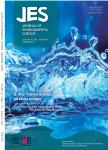A bibliometric review of nitrogen research in eutrophic lakes and reservoirs
A bibliometric review of nitrogen research in eutrophic lakes and reservoirs作者机构:Taihu Laboratory for Lake Ecosystem Research State Key Laboratory of Lake Science and Environment Nanjing Institute of Geography and Limnology Chinese Academy of Sciences Nanjing 210008 China University of Chinese Academy of Sciences Beijing 100049 China
出 版 物:《Journal of Environmental Sciences》 (环境科学学报(英文版))
年 卷 期:2018年第30卷第4期
页 面:274-285页
核心收录:
基 金:supported by the International Science & Technology Cooperation Program of China (No. 2014DFG91780) the National Natural Science Foundation of China (Nos. 41325001, 41230744 and 41621002)
主 题:Nitrogen Eutrophication Research hotspots Trends Bibliometric
摘 要:The global application of nitrogen is far greater than phosphorus, and it is widely involved in the eutrophication of lakes and reservoirs. We used a bibliometric method to quantitatively and qualitatively evaluate nitrogen research in eutrophic lakes and reservoirs to reveal research developments, current research hotspots, and emerging trends in this area. A total of 2695 articles in the past 25 years from the online database of the Scientific Citation Index Expended(SCI-Expanded) were analyzed. Articles in this area increased exponentially from 1991 to *** the USA was the most productive country over the past 25 years, China achieved the top position in terms of yearly publications after 2010. The most active keywords related to nitrogen in the past 25 years included phosphorus, nutrients, sediment, chlorophyll-a, carbon,phytoplankton, cyanobacteria, water quality, modeling, and stable isotopes, based on analysis within 5-year intervals from 1991 to 2015 as well as the entire past 25 years. In addition, researchers have drawn increasing attention to denitrification, climate change, and internal loading. Future trends in this area should focus on:(1) nutrient amounts, ratios, and major nitrogen sources leading to eutrophication;(2) nitrogen transformation and the bioavailability of different nitrogen forms;(3)nitrogen budget, mass balance model, control, and management;(4) ecosystem responses to nitrogen enrichment and reduction, as well as the relationships between these responses; and(5)interactions between nitrogen and other stressors(e.g., light intensity, carbon, phosphorus, toxic contaminants, climate change, and hydrological variations) in terms of eutrophication.



